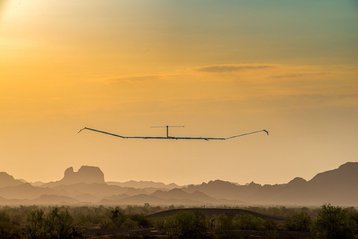A High Altitude Pseudo Satellite (HAPS) developed and flown by Airbus has crashed outside Arizona.
HAPS – whether they be airships, balloons, or fixed-wing drones – offer a way to provide connectivity to rural and unconnected areas without the upfront costs of cell towers or satellites or the need for specialist receivers. Google/Alphabet's now-defunct high altitude balloon unit Project Loon was probably the most famous example, but a number of companies are looking to develop a successful platform in the space.
First reported by Simple Flying, one of Airbus’ fixed-wing, solar-powered Zephyr platforms was lost last week while flying over Arizona for 64 straight days. It was within hours of breaking the record for the longest flight in history.
"Following 64 days of stratospheric flight and the completion of numerous mission objectives, Zephyr experienced circumstances that ended its current flight,” an Airbus spokesperson told SF. “No personal injury occurred. Our teams are currently analyzing more than 1,500 hours of stratospheric mission data. The valuable experience from this prototype’s ultra-long endurance flight has proved to be a positive step toward the Army’s high-altitude platform goals."
Flying under callsign ZULU82, it had spent most of the past two months in the southwestern parts of the United States around the Arizona Desert, cruising around at altitudes of 60-70,000 feet.
SF said that on its final day of operations, the Zephyr was flying at a lower altitude than normal – around 45,000 - 50,000 feet - between Phoenix and Mexicali, Baja California. After completing an S-shape maneuver at around 50 - 60 knots, something went wrong. Data from ADSB Exchange shows the platform’s vertical descent rate increased rapidly, topping out at a speed of 4,544 feet per minute before losing contact with ground controllers.
This isn’t the first time a Zephyr has been lost. Turbulence triggered an uncontrolled spiral descent and subsequent in-flight break-up of a Zephyr above Australia in 2019. Another Zephyr crashed after departing from the same Wyndham airport in Western Australia earlier that year, again due to weather.
The flight came within hours of beating the 63-year-old record for the longest recorded flight, held by two pilots using a Cessna 172 Skyhawk.
British defense contractor Qinetiq began developing the Zephyr platform in 2003 and sold it to Airbus in 2013. The platform has a wingspan of 25 meters (82 ft) and weighs 75 kilograms (165 lb).
Airbus recently launched a new connectivity services business; the dedicated HAPS Services Business will be based around its fixed-wing Zephyr platform. The new business will offer telecommunications services via its platform, and sit as a subsidiary of Airbus Defence and Space.
In 2018, Airbus flew the Zephyr S from Arizona and remained aloft for 25 days 23h 57min. The company has made other successful test flights more recently, with three planes in service, and recently completed a successful trial of HAPS-delivered broadband with NTT's DOCOMO.
Governments are looking at HAPS for defense purposes, while telecoms firms are hoping the platforms will be able to provide another option between terrestrial cell towers and satellite communications to provide Internet coverage, especially in remote or crisis areas.
While Google’s now-defunct balloon-based Loon Project was the most high-profile HAPS project, companies including SoftBank, Deutsche Telekom, and BAE are also working on their own platforms.
Airbus isn’t the only company to experience incidents with HAPS. Meta’s (then-Facebook) fixed-wing Aquila project managed just two test flights, the first of which in 2016 ended in a crash. The company killed off the project in 2018. Google’s own fixed-wing Project Titan managed just one failed test flight in 2015 before the program was killed off in 2017.
Though more successful, Google’s Loon project was even more accident-prone. The company’s balloons were known to have crashed in Washington, South Africa, and New Zealand in 2014; California and Mexico in 2015; Sri Lanka and Chile in 2016; Kenya in 2017; Texas in 2018, and the Democratic Republic of the Congo (DRC) in 2020.







